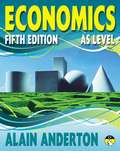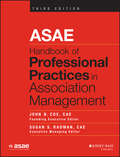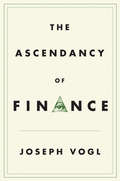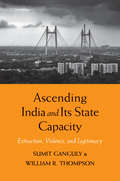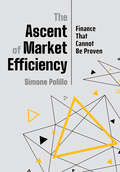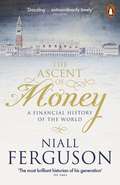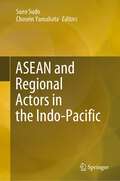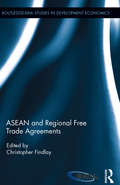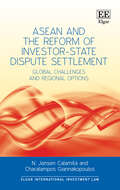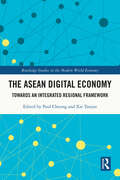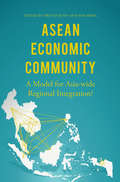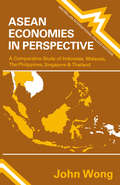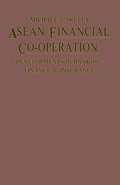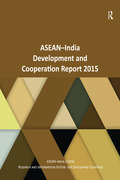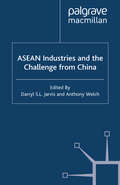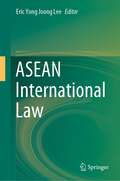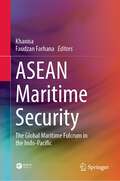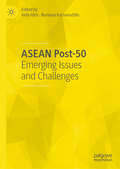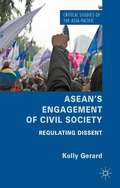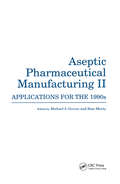- Table View
- List View
AS Level Economics Student Book (5th edition) (PDF)
by Alain AndertonThis bestselling text has been extensively revised, reorganised and updated for the NEW AS Level Economics specifications that start teaching from September 2008. New Edition suitable for ALL boards including IB and OCR covers the new content of the specifications and address the changes to the assessment format. Motivates students and enhances the clarity of diagrams, figures, tables and charts with the engaging full colour design . Supports the analysis of economic situations with the most recent statistics . Embeds theory in real life examples with the latest economic theories and applied economics in every unit.
As Per My Previous Email ...: Decode Your Inbox, One Pass-Agg Message At A Time
by Steve BurdettChange your outlook. Win at work. Boss every Pass-Agg office situation ever with this hilarious survival guide.Spending most of our lives at work, it's no wonder tensions run high. We've all been cc'd (code for 'this isn't my problem'), we've all received the 'thanks in advance' (code for 'you don't have a choice') and we've all relished the moment when we can send the 'As per my previous' (code for 'see the email I already sent, you moron'). Includes: Subject Field StressesThe Passive-aggressive Art of Copying InCulling of the Dear: Salutations!'Hope You're Well...': and other rage-inducing Opening LinesDirect Mail: Getting to the Point XXXX: Navigating Awkward Sign offs and SignaturesDouble-O Nothing: Weird and Pointless Out Of OfficeThis laugh-out-loud book translates the most unbelievable Pass-Agg, rage-inducing things we say and do on office email, what they say about the sender, and offers helpful lines so you will always win at work.
ASAE Handbook of Professional Practices in Association Management
by John B. CoxA new edition of one of the flagship books for CAE preparation The ASAE Handbook of Professional Practices in Association Management covers the core functions of association management at a high but practical level, making it a go-to resource for professionals who are leading and managing membership organizations and those preparing for the Certified Association Executive (CAE) credential. Now in its third edition, this core text in the ASAE association literature offers practical, experience-based insights, strategies, and techniques for managing every aspect of an association or membership organization. Organized into 35 chapters and presenting information based on experience and proven research into the skills and knowledge required for successfully managing an organization of any size, this book covers governance and structure, leadership processes, management and administration (including finance and human resources), internal and external relations, programs and services, and much more. This new edition incorporates increased emphasis on the c-level judgment required of Certified Association Executives and CEO-aspirants, as well as more comprehensive coverage of essential functions such as planning. Covers the range of functions essential to managing an association Serves as a flagship handbook for CAE prep and is one of only five designated "CAE Core Resources"; new edition is applicable to prep beginning with the May 2015 CAE exam Information is relevant and applicable to students and professionals alike Edited by the founding editor of Professional Practices in Association Management and a CAE instructor with more than 30 years of experience in preparing CAEs Put the experts to work for you with this essential resource—written by association professionals and experts with 300 years of cumulative experience!
ASAE Handbook of Professional Practices in Association Management
by John B. Cox Susan S. RadwanA new edition of one of the flagship books for CAE preparation The ASAE Handbook of Professional Practices in Association Management covers the core functions of association management at a high but practical level, making it a go-to resource for professionals who are leading and managing membership organizations and those preparing for the Certified Association Executive (CAE) credential. Now in its third edition, this core text in the ASAE association literature offers practical, experience-based insights, strategies, and techniques for managing every aspect of an association or membership organization. Organized into 35 chapters and presenting information based on experience and proven research into the skills and knowledge required for successfully managing an organization of any size, this book covers governance and structure, leadership processes, management and administration (including finance and human resources), internal and external relations, programs and services, and much more. This new edition incorporates increased emphasis on the c-level judgment required of Certified Association Executives and CEO-aspirants, as well as more comprehensive coverage of essential functions such as planning. Covers the range of functions essential to managing an association Serves as a flagship handbook for CAE prep and is one of only five designated "CAE Core Resources"; new edition is applicable to prep beginning with the May 2015 CAE exam Information is relevant and applicable to students and professionals alike Edited by the founding editor of Professional Practices in Association Management and a CAE instructor with more than 30 years of experience in preparing CAEs Put the experts to work for you with this essential resource—written by association professionals and experts with 300 years of cumulative experience!
The Ascendancy of Finance
by Joseph VoglThe global financial crisis of 2008 ushered in a system of informal decision-making in the grey zone between economics and politics. Legitimized by a rhetoric of emergency, ad hoc bodies have usurped democratically elected governments. In line with the neoliberal credo, the recent crisis has been used to realize the politically impossible and to re-align executive power with the interests of the finance industry. In this important book, Joseph Vogl offers a much longer perspective on these developments, showing how the dynamics of modern finance capitalism have always rested on a complex and constantly evolving relationship between private creditors and the state. Combining historical and theoretical analysis, Vogl argues that over the last three centuries, finance has become a "fourth estate," marked by the systematic interconnection of treasury and finance, of political and private economic interests. Against this historical background, Vogl explores the latest phase in the financialization of government, namely the dramatic transfer of power from states to markets in the latter half of the 20th century. From the liberalization of credit and capital markets to the privatization of social security, he shows how policy has actively enabled a restructuring of the economy around the financial sector. Political systems are "imprisoned" by the regime of finance, while the corporate model suffuses society, enclosing populations in the production of financial capital. The Ascendancy of Finance provides valuable and unsettling insight into the genesis of modern power and where it truly resides.
The Ascendancy of Finance
by Joseph VoglThe global financial crisis of 2008 ushered in a system of informal decision-making in the grey zone between economics and politics. Legitimized by a rhetoric of emergency, ad hoc bodies have usurped democratically elected governments. In line with the neoliberal credo, the recent crisis has been used to realize the politically impossible and to re-align executive power with the interests of the finance industry. In this important book, Joseph Vogl offers a much longer perspective on these developments, showing how the dynamics of modern finance capitalism have always rested on a complex and constantly evolving relationship between private creditors and the state. Combining historical and theoretical analysis, Vogl argues that over the last three centuries, finance has become a "fourth estate," marked by the systematic interconnection of treasury and finance, of political and private economic interests. Against this historical background, Vogl explores the latest phase in the financialization of government, namely the dramatic transfer of power from states to markets in the latter half of the 20th century. From the liberalization of credit and capital markets to the privatization of social security, he shows how policy has actively enabled a restructuring of the economy around the financial sector. Political systems are "imprisoned" by the regime of finance, while the corporate model suffuses society, enclosing populations in the production of financial capital. The Ascendancy of Finance provides valuable and unsettling insight into the genesis of modern power and where it truly resides.
Ascending India and Its State Capacity: Extraction, Violence, and Legitimacy
by Sumit Ganguly William R. ThompsonA comprehensive and revealing account of the ongoing struggles and instability of India’s political and economic institutions India’s ascent as a formidable power on the world stage and its geopolitical ramifications have received much attention in recent years. This comprehensive study by Sumit Ganguly and William Thompson, two highly distinguished scholars of political science and international relations, delves into the intricate inner workings of this great Asian nation to reveal an Indian state struggling to maintain national security, domestic order, and steady fiscal growth despite weaknesses in its economic and political institutions. The authors’ sobering account questions India’s perceived strengths and domestic and foreign policy initiatives, while focusing on the South Asian giant’s infrastructural and economic growth problems, opposition to reform, and other important hurdles the nation has faced and will continue to face over the coming decade and beyond.
The Ascent of Market Efficiency: Finance That Cannot Be Proven
by Simone PolilloThe Ascent of Market Efficiency weaves together historical narrative and quantitative bibliometric data to detail the path financial economists took in order to form one of the central theories of financial economics—the influential efficient-market hypothesis—which states that the behavior of financial markets is unpredictable.As the notorious quip goes, a blindfolded monkey would do better than a group of experts in selecting a portfolio of securities, simply by throwing darts at the financial pages of a newspaper. How did such a hypothesis come to be so influential in the field of financial economics? How did financial economists turn a lack of evidence about systematic patterns in the behavior of financial markets into a foundational approach to the study of finance?Each chapter in Simone Polillo's fascinating meld of economics, science, and sociology focuses on these questions, as well as on collaborative academic networks, and on the values and affects that kept the networks together as they struggled to define what the new field of financial economics should be about. In doing so, he introduces a new dimension—data analysis—to our understanding of the ways knowledge advances.There are patterns in the ways knowledge is produced, and The Ascent of Market Efficiency helps us make sense of these patterns by providing a general framework that can be applied equally to other social and human sciences.
The Ascent of Money: A Financial History of the World
by Niall FergusonBread, cash, dough, loot, lucre, the wherewithal: call it what you like, it matters. To Christians, love of it is the root of all evil. To generals, it’s the sinews of war. To revolutionaries, it’s the chains of labour. But in The Ascent of Money, Niall Ferguson shows that finance is in fact the foundation of human progress. What’s more, he reveals financial history as the essential back-story behind all history, with the development of credit and debt as important as any technological innovation in the rise of civilisation.The evolution of credit and debt was as important as any technological innovation in the rise of civilization, from ancient Babylon to the silver mines of Bolivia. Banks provided the material basis for the splendours of the Italian Renaissance, while the bond market was the decisive factor in conflicts from the Seven Years’ War to the American Civil War.With the clarity and verve for which he is famed, Niall Ferguson explains why the origins of the French Revolution lie in a stock market bubble caused by a convicted Scots murderer. He shows how financial failure turned Argentina from the world’s sixth richest country into an inflation-ridden basket-case – and how a financial revolution is propelling the world’s most populous country from poverty to power in a single generation.Yet the most important lesson of the financial history is that sooner or later every bubble bursts – sooner or later the bearish sellers outnumber the bullish buyers – sooner or later greed flips into fear. And that’s why, whether you’re scraping by or rolling in it, there’s never been a better time to understand the ascent of money.
ASEAN and Regional Actors in the Indo-Pacific
by Sueo Sudo Chosein YamahataThis book discusses the shifting regional geopolitical engagements and development of rearranged connections emerging among ASEAN and non-ASEAN actors.First, the book focuses on the crucial discourse surrounding the Indo-Pacific region, including its challenges, continuity, and relevance. The discussion highlights the growing influence of regional actors such as India, Thailand, Japan, and the US, particularly in the context of a pressing question of collaboration versus containment amidst China’s rise. The book delves into various topics, such as geopolitical anxieties, economic strength, foreign policy, international relations, development, and security promotion in South and Southeast Asia, through the lenses of ASEAN centrality and the Indo-Pacific strategy.Second, the volume emphasizes on the escalating tensions and the worsening crises in the region that cause major anxieties and the subsequent realignment and new alignment of countries’ relationships. Among several chapters of the volume, a large Indo-China state, Myanmar, takes a special place in the book’s discussions as it has grown as an important ground for a resource/energy race among geopolitically strategic partners. Additionally, Myanmar has the potential to become a balancer in ASEAN. Therefore, any positive development and change in course of relations to Myanmar, particularly with its neighbors, Japan, and Russia, in both historical and contemporary contexts, can have a significant impact not only on Myanmar’s course towards peace, democracy, and security, but also regional stability. The editors and contributors examine the unique position of ASEAN, with a focus on ASEAN centrality as a platform for addressing anxieties and building relationships to bridge the gap between world and regional players, including both friends and foes.Overall, the volume provides valuable insights into the Indo-Pacific region’s complex dynamics, including cooperation and collaboration among regional actors for long-term stability and prosperity. The interdisciplinary composition of the book invites readers from various backgrounds to engage with constructive debates on general perception, contextual discussion, and the highlights of engaged research from local and international perspectives.
ASEAN and Regional Free Trade Agreements (Routledge-ERIA Studies in Development Economics)
by Christopher FindlayEfforts to use existing trade agreements to build a larger regional agreement face many challenges. This book considers this problem with reference to ASEAN’s current agreements with key partners and the interest to build the Regional Comprehensive Economic Partnership (RCEP). The analysis of the options is framed by a focus on the use of supply chains in international business. Issues considered include those related to reductions in tariffs, trade facilitation, the treatment of investment and of services and the definition of rules of origin. The work is informed by case studies of supply chains in automobile and electronics, and in a professional service sector. The book provides a set of priority actions for better progress in taking a bottom-up approach to building RCEP.
ASEAN and Regional Free Trade Agreements (Routledge-ERIA Studies in Development Economics)
Efforts to use existing trade agreements to build a larger regional agreement face many challenges. This book considers this problem with reference to ASEAN’s current agreements with key partners and the interest to build the Regional Comprehensive Economic Partnership (RCEP). The analysis of the options is framed by a focus on the use of supply chains in international business. Issues considered include those related to reductions in tariffs, trade facilitation, the treatment of investment and of services and the definition of rules of origin. The work is informed by case studies of supply chains in automobile and electronics, and in a professional service sector. The book provides a set of priority actions for better progress in taking a bottom-up approach to building RCEP.
ASEAN and the Reform of Investor-State Dispute Settlement: Global Challenges and Regional Options (Elgar International Investment Law series)
by Nicolas J. Calamita Charalampos GiannakopoulosThe reform of Investor-State Dispute Settlement (ISDS) is a subject of ongoing debate in international institutions, yet an ASEAN perspective on the subject has been largely absent to date. This book addresses that gap by presenting, analysing and assessing ISDS reform from an ASEAN perspective, taking into account the experience, needs and concerns of ASEAN as a community and of its member states.The book provides a consolidated summary of the range of ISDS reform proposals that have been put forward internationally, alongside a systematic overview of the ISDS provisions of over 300 international investment agreements concluded by ASEAN and its member states. Combining this information, the authors critically analyse the content, structure and modalities of reform proposals from an ASEAN standpoint, including their ability to address reform concerns particular to ASEAN member states. Chapters explore a wide range of topics, covering the rationale, modalities and concerns involved in ISDS reform.The book will be of interest to academics and graduate students in the fields of international investment law and ASEAN law and policy. It will also be of relevance to policy-makers in ASEAN, and more broadly, to practitioners and arbitrators who are interested in ISDS reform.
The ASEAN Digital Economy: Towards an Integrated Regional Framework (Routledge Studies in the Modern World Economy)
by Paul Cheung Xie TaojunBoasting the fastest growing Internet market in the world, Association of Southeast Asian Nations (ASEAN) is accelerating into the digital economy. This book assesses the potential economic impact of digital economy agreements (DEAs) and the readiness of some ASEAN member states to grow the digital economy in collaboration. The book presents a novel framework to assess countries’ readiness to enter digital economy collaborations, following the architecture of Singapore’s DEAs with its trading partners. It takes a bird’s-eye view of the digital economy in ASEAN and reviews the current state of digital infrastructure and regulations. The book also includes simulation exercises to project economic outcomes delivered by regional collaborations. It also elaborates on the specific strengths and weaknesses of five ASEAN member states. These ASEAN member states include Indonesia, Malaysia, the Philippines, Vietnam, and Cambodia. The book concludes by revisiting the ASEAN economy as a whole. It points out key issues country leaders need to work on as they proceed with digital economy collaborations. This book is written for scholars, policymakers, and industrial practitioners who wish to learn the latest developments in the ASEAN digital economy.
The ASEAN Digital Economy: Towards an Integrated Regional Framework (Routledge Studies in the Modern World Economy)
Boasting the fastest growing Internet market in the world, Association of Southeast Asian Nations (ASEAN) is accelerating into the digital economy. This book assesses the potential economic impact of digital economy agreements (DEAs) and the readiness of some ASEAN member states to grow the digital economy in collaboration. The book presents a novel framework to assess countries’ readiness to enter digital economy collaborations, following the architecture of Singapore’s DEAs with its trading partners. It takes a bird’s-eye view of the digital economy in ASEAN and reviews the current state of digital infrastructure and regulations. The book also includes simulation exercises to project economic outcomes delivered by regional collaborations. It also elaborates on the specific strengths and weaknesses of five ASEAN member states. These ASEAN member states include Indonesia, Malaysia, the Philippines, Vietnam, and Cambodia. The book concludes by revisiting the ASEAN economy as a whole. It points out key issues country leaders need to work on as they proceed with digital economy collaborations. This book is written for scholars, policymakers, and industrial practitioners who wish to learn the latest developments in the ASEAN digital economy.
ASEAN Economic Community: A Model for Asia-wide Regional Integration?
by Bruno Jetin Mia MikicThe launch of the ASEAN Economic Community raises key issues: the deepening of regional trade and the associated problem of exchange rate management. This volume questions the capacity of a shallow institution to deal with complex impacts on employment and inequality. Contributors analyze ASEAN's potential and weakness in readable terms.
ASEAN Financial Co-Operation: Developments in Banking, Finance and Insurance (pdf)
by Michael T. SkullyASEAN-India Development and Cooperation Report 2015
by Asean�ndia CentreIndia‘s engagement with the Association of Southeast Asian Nations (ASEAN) is at the heart of its Look East Policy. As a regional bloc, ASEAN has developed much faster than any of the other blocs in the Asia-Pacific. With ASEAN and India working towards establishing a Comprehensive Free Trade Area through Regional Comprehensive Economic Partnership Agreement (RCEP), their cooperation will be key to promoting economic stability, competitiveness, growth and integration in the region. This Report: provides a comparative analysis of the global and regional economies; examines the impact and implications of India ASEAN integration; assesses policy priorities, effectiveness, implementation imperatives and challenges; and discusses themes central to the economic sustainability of the region, including public and foreign policy, trade facilitation, financial and scientific cooperation, food security, energy cooperation, and productivity and opportunities in the manufacturing and service sectors. It will be invaluable to scholars and researchers of economics, international relations, development studies, area studies, as well as policy-makers, administrators, private sector professionals, and non-governmental organisations in the field.
ASEAN Industries and the Challenge from China
by Darryl S.L. Jarvis & Anthony WelchThis book explores the impact of the rise of China on South East Asia, addressing the consequences for some of Asia's key economic sectors, including educational services, bio-technology, financial services, and the food industry, among others.
ASEAN International Law
by Eric Yong Joong LeeThis book consists of updated and refreshed papers written by international law scholars and practitioners from the ASEAN region and published by the Journal of East Asia and International Law, comprehensively covering almost all contemporary international legal issues related to ASEAN.Legal analysis of the ASEAN integration as one community with one vision in this book provides readers with a better understanding of the current social climate and future developments of ASEAN. Each section within the book covers a highly topical issue on ASEAN cooperation and dispute resolution from an international law perspective. ASEAN is one of the biggest economic communities in the world and the ASEAN+3 covers nearly half of global GDP. Given the region’s global impact, this book is of interest to Asia watchers, academics and policymakers alike.
ASEAN Maritime Security: The Global Maritime Fulcrum in the Indo-Pacific
by Khanisa Faudzan FarhanaThis book covers various strategic issues around maritime security in terms of how Indonesia has sought to implement its Global Maritime Fulcrum (GMF) vision, evaluating its regional impact within ASEAN. The Global Maritime Fulcrum’ vision was declared by President Joko Widodo to refocus Indonesia’s development paradigm to prioritize its maritime aspect in the Indo-Pacific. Divided across five pillars, namely: maritime culture, maritime resource management, maritime infrastructure and connectivity development, maritime diplomacy and maritime defense, the book presents that the implementation of this vision will doubtless have a significant regional impact, particularly in setting regional maritime agendas. In promoting an understanding of the challenges presented in implementing the Global Maritime Fulcrum and unpacking its multifaceted impact in the region, this book delves into Indonesia’s maritime vision, the existing maritime arrangements within ASEAN, and Indonesia’s interests in terms of its political economy relating to the maritime sector, strategic security issues, maritime diplomacy, and related regional power dynamics. Translated from Bahasa Indonesia into English, the book is relevant to scholars and policymakers in maritime studies, international relations, and regional studies relating to politics and power dynamics in Indonesia, specifically, and ASEAN more broadly.
ASEAN Post-50: Emerging Issues and Challenges
by Aida Idris Nurliana KamaruddinThe first 50 years of ASEAN integration has brought peace and prosperity to the Southeast Asian region, while the next 50 will undoubtedly be fraught with unprecedented challenges. Today ASEAN not only has to contend with its own internal challenges arising from the highly diverse political, economic and socio-cultural systems of its member countries, it also has to deal with external factors which include shifts in geostrategic balance, fraying global consensus on free trade, populism and xenophobia, climate change, digital revolutions and cybercrimes.Set against the above background, this edited collection considers some of the contemporary issues and challenges faced by ASEAN in its journey towards more cohesive and dynamic regional integration. Among the topics explored are ASEAN’s evolving partnerships with its key strategic partners including China and the United States on economic policies and strategies, educational systems and frameworks, migration and environmental threats.
ASEAN's Engagement of Civil Society: Regulating Dissent (Critical Studies of the Asia-Pacific)
by Kelly GerardThis book offers an innovative framework for understanding the role of civil society in regional and global policymaking. Using political economy analysis, Gerard demonstrates that ASEAN's people-oriented agenda builds legitimacy, while sidelining its detractors.
Aseptic Pharmaceutical Manufacturing II: Applications for the 1990s
by Michael J. Groves Ram MurtyAsceptic Pharmaceutical Manufacturing II explores the sophisticated technology, developments, and applications that allow aseptic processing to approach the sterility levels achieved with terminal sterilization. Written by experts in sterile manufacturing, this book covers aseptic technology, developments, and applications and makes a valuable contribution to understanding the issues involved in aseptic manufacture. Topics include the processing of biopharmaceuticals, lyophilization, personnel training, radiopharmaceuticals, hydrogen peroxide vapor sterilization, regulatory requirements, validation, and quality systems.
